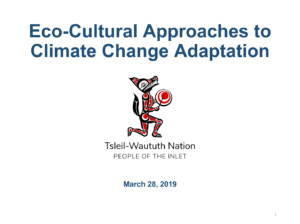Outcomes of climate change on water include rising sea levels, warmer sea surface temperatures, and shifts in precipitation types, timing, and amounts. These outcomes have an impact on Indigenous Peoples’ relationship with water. Indigenous communities continue to draw from Traditional Ecological Knowledge (TEK) to maintain the overall vitality of human-water ecosystems in the context of climate change.
Sea surface temperatures have been increasing steadily throughout the 20th century and this trend continues. Changes in ocean temperature affect the ongoing presence of plants, fish life, and other animals. Increases in water temperature have also significantly altered the migration and breeding patterns of sea life, including shellfish. Another key impact is the presence and the frequency of the recurrence of “red tide,” a harmful algal bloom (HAB). Harmful algal blooms are toxic microscopic organisms (also known as cyanobacteria) that feed off the energy of light to grow; they are fatal to marine life, and can make humans sick.
The Southeast Alaska Tribal Ocean Research (SEATOR) network has been monitoring, sampling, and reporting on the levels of toxins among shellfish around the Alaskan Panhandle. SEATOR benefits from Indigenous Traditional Ecological Knowledge to help to predict harmful algal blooms (HAB), reduce poisoning, and harvest shellfish more effectively. Traditional harvesting practices of the Indigenous Peoples of Alaska help to keep Indigenous communities safe from the effects of HAB.
In another example of applying Indigenous Knowledge to manage human-water ecosystems, the Heiltsuk Nation (Bella Bella, British Columbia), on the West Coast of Canada, are applying traditional harvest practices, to facilitate the natural regeneration and resilience of kelp, at a small scale. With the assistance of researchers from the School of Resource and Environmental Management at Simon Fraser University, the Heiltsuk Nation are showing how their stewardship practices can help manage the growth of perennial kelp to make the kelp resilient to changes in the climate. University researchers were “motivated by the information needs” of the Heiltsuk Nation and together they co-designed a study to “measure the ecological resilience of feather boa kelp…and determine what environmental variables most affected its recovery.” The combination of Traditional Ecological Knowledge and Western scientific practices permitted the researchers to explore how the social relationship of the Heiltsuk Peoples to the ecological resilience of their environment are affected by increases in ocean temperatures.
Colonization compounds the effect of climate change (and vice-versa) on human-water ecosystem relationships. In Madagascar, for example, while rising sea levels have displaced Indigenous communities, conventionally, being nomadic, by choice, was also a way for Indigenous Peoples to deal with the unpredictability of the climate. However, a shift to sedentary lifestyles, further entrenched by modernization and colonization, have also affected human-water ecosystem relationships in Madagascar.
Drawing from a wide variety of Indigenous bodies of knowledge rooted in both Indigenous experiences and practices, shed light on different ways to manage climate change effects and to better understand the fine balance of human-water ecosystems in a changing climate.
By Leela Viswanathan
(Image Credit: Frank McKenna, Unsplash)




